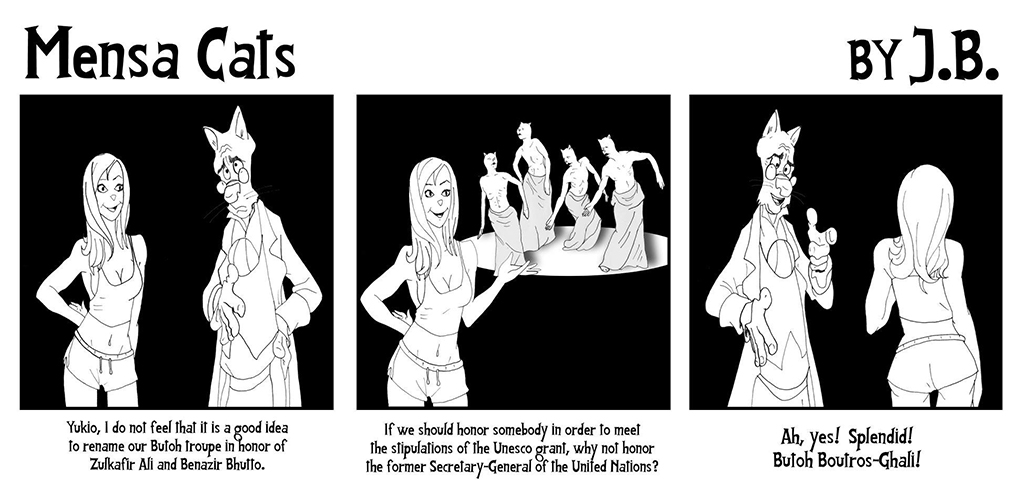

Today’s Mensa Cat strips explore the world of butoh dance. By J.B.

Today we look back at I performance I saw in July, an early performance of “The Line Between” in The Bowls Project, an installation at Yerba Buena Center for the Arts in San Francisco. Although the performance took place in the white domes set up for The Bowls Project, it was really a separate work.
The Line Between is collaboration of musicians Jason Ditzian, Suki O’kane, and Frank Lee with Shinichi Iova-Koga and Dohee Lee of inkBoat. Like other butoh performances that I have seen, such as the Emergency (X)tet at the Meridian Gallery in July, it involved very slow and deliberate motion, stark white coloring and an absurdist quality. This performance also including vocals, which was an element I had not heard before. Set against the minimalist musical background of percussion, bass clarinet and portable electronics, the dancers played with the space of the domes and the audience, who sat on various cushions arranged throughout. Some of the motions were very slow and serious, and in time with the rhythms of the music. Others were more playful, such as climbing on the outside of dome. The music provided moments of steady drumming, tonal and extended-technique sounds from the bass clarinet, and bits of noise from the electronics. There were lots of empty and silence spaces in which the dancers could take the audience by surprise.
In keeping with the stark nature of the performance itself, I think it is best reviewed through images:
In the two photos looking upwards, one gets a sense of how this unique performance and setting is still situated within the surrounding landscape of the city.
Look for one more to appear this Wednesday.
Although this performance took place over two months ago, it is in a way a timely review. Dohee Lee will be appearing in PURI 5: “SPoRA” at the Oakland Asian Cultural Center on October 16, an event I am looking forward to attending.
Last Saturday I attended a performance of the Emergency (X)tet at the Meridian Gallery. Unlike a normal string quartet or quintet, the number of performers in the (X)tet is variable. And on this particular evening X was equal to 7, with Adria Otte, Angela Hsu, and Jonathan Segel on violin, Bob Marsh and Doug Carroll on cello, Kanoko Nishi on bass koto, and Tony Dryer on contrabass.
All Emergency (X)tet performances involve free improvisation. But like all good free improvisation, a structure emerges within each piece. Some sections focused on short tone bursts, others on long harmonics, and others on extended techniques such as striking the body of the instrument. I particularly noticed the use of “prepared violin”, in which objects were inserted between the strings of the violin to change the timbre and performance characteristics (similar to a prepared piano). At various points the violins as well as the contrabass were all performing with various rods inserted in between the strings.
In the second half of the performance, the string (X)tet was joined by Kinji Hayashi performing butoh dance. Butoh dance emerged in post-World War II Japan. Most performances of butoh that I have seen involve very slow and deliberate motion, usually in white make-up and has an overall dark or absurdist theme. As with the purely instrumental pieces, the dance movements were improvised in response to the music, but it had an overall structure. Hayashi first emerged from the hall covered in newspaper, forming a sort of a sort of “newspaper monster” or large mass moving slowly. Every so often, one could glimpse his hands or face underneath.

[Click to enlarge image.]
The slow movements were punctuated by dramatic or even comical fast motions (at one point, an audience member’s purse was pulled underneath the newspaper). As the piece unfolded, more and more of the newspaper was cast away to reveal the dancer in full traditional costume, with dramatic movements along the full length of Meridian’s performance space. As with many improvised pieces, the ending came at an unexpected moment.
On display at the Meridian Gallery during the performance was the exhibition The Candy Store featuring the work of John deFazio and Leigha Mason. DeFazio’s 100 Xerox collages based on cantos from Dante’s Divine Comedy was on display in the music room, and was probably the closest aligned to my artistic interests, featuring graphic and text images in black and white. Some were abstract, some featured cultural or historical references, others included disturbing imagery. He also designed several large funerary urns with very whimsical designs dedicated to mythical figures as well as popular culture. The title piece for the exhibition was Mason’s life-size candy shop installtion. The resin and sugar objects are bright and translucent, and seem very inviting, until one gets closer and sees the hair and fingernails embedded within. Mason seems to play upon this mixture of invitation and revulsion, which also was apparent in her accompanying drawings that featured children with grotesque faces expressing joy, perhaps that of “kids in a candy store”.